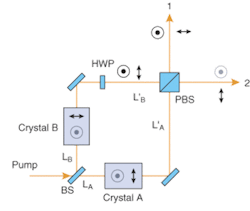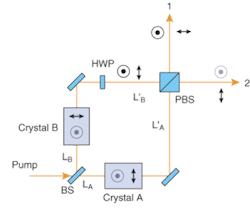Bright source of entangled photons aids teleportation research
Recent progress toward realizing the key technological elements needed for long-distance, high-fidelity quantum-bit teleportation was described in an invited paper by Jeff Shapiro of MIT (Cambridge, MA) at the 2003 OSA Frontiers in Optics meeting (Oct. 5–9, Tucson, AZ).1 Shapiro summarized work done by a collaboration between researchers at MIT and Northwestern University (Evanston, IL)2 and discussed a bright source of entangled photons. Marco Fiorentino and others in Shapiro's group created a source that emits about 12,000 polarization-entangled pairs/s per milliwatt of pump power, which is an order of magnitude more photons than previous continuous-wave devices supplied.3
Quantum teleportation
Teleportation, in this case, refers to a spooky quantum phenomenon. Assume one knows the wave function describing a photon. If that photon downconverts into two photons with smaller energies, then the sum of the new photons' wave functions is equal to the wave function of the first photon. The two new photons are inextricably linked, no matter how far from each other they may travel. Therefore, if the polarization of the original photon is known, and the polarization of one of the new photons is measured, then the polarization of the other new photon is instantly known—no matter how far away it might be. The spooky part is that, like Schrodinger's cat (which is in both a living and dead state until it is observed, at which point it snaps into one or the other state), both photons can have indeterminate polarization until one is measured. Performing an experiment on one photon of an entangled pair instantaneously affects its partner at a distance.
Experiments have proven that one can use a pair of entangled states as a carrier to carry the properties of the original state to a different place, without observing them. The characteristics of quantum-entangled photons lead to potential quantum-information technology, including long-distance communication, quantum cryptography, and quantum computing.
Brighter is better
Polarization-entangled photons can be made by optical parametric downconversion, a nonlinear process that turns a single high-energy short-wavelength photon into two lower-energy longer-wavelength photons. These nonlinear processes typically require high energy densities; one has the choice of either using powerful (and power-hungry) lasers to make many entangled photons or much less powerful lasers to make many fewer entangled photons. While considerable progress has been made in this area, research-ers still strive for an ideal source that produces output consisting of many entangled photon pairs as efficiently as possible.
Currently, the output of a type-II spontaneous parametric downconversion (SPDC) in nonlinear crystals must be spatially and spectrally filtered to obtain only entangled and usable photon pairs. Other researchers have suggested combining the output of two different SPDC crystals interferometrically to produce entangled photons independent of their wavelengths and angles of emission (see Fig. 1). All the photons emerging from the inteferometer should be entangled, regardless of their wavelengths and directions of emission, eliminating the need to filter them. Also, such a source should get rid of timing distinguishability and offer both nondegenerate operation and source tunability. Despite the theoretical promise, experiments in building such a device have run into problems with alignment. The problem seems to stem from differences in the two crystals.
FIGURE 2. A source of polarization-entangled photons uses one periodically poled (PP) KTP crystal with collinear counterpropagating pump beams, rather than using separate nonlinear crystals as in the conventional setup. Dichroic mirrors (DMs) on either side of the nonlinear crystal extract the downconverted light. A half-wave plate (HWP2) rotates the polarization of light by 90° in one arm of the interferometer before both beams recombine at the polarizing beamsplitter (PBS). Another half-wave plate (HWP1) balances the flux of downconverted photons in the two directions. The output is passed through irises, polarization analyzers, and interference filters (IF) before hitting single-photon detectors.
Members of Shapiro's group realized that they could eliminate problems with crystal differences by using a single crystal. They added mirrors to the conventional scheme, resulting in pump beams counterpropagating through a single crystal (see Fig. 2). The researchers used a 10-mm-long, 1-mm-thick, 4-mm-wide periodically poled KTP (potassium titanyl phosphate) crystal with a grating period of 9.0 µm. The temperature was controlled to phase-match the period with the 398.5-nm pump beam from a frequency-doubled continuous-wave Ti:sapphire laser. Using this system, with a 3-nm interference filter and a 4-mm-wide iris, the researchers measured a flux of about 12,000 polarization-entangled pairs/s per milliwatt of pump power.
REFERENCES
- J. H. Shapiro, et al., Paper MI3, Frontiers in Optics, OSA, Oct. 5-9, Tucson, AZ.
- http://www.rle.mit.edu/quantummuri.
- M. Fiorentino, et al., paper submitted to Phys. Rev. Lett.


